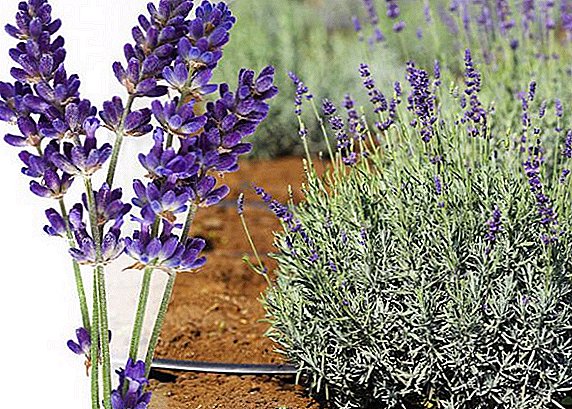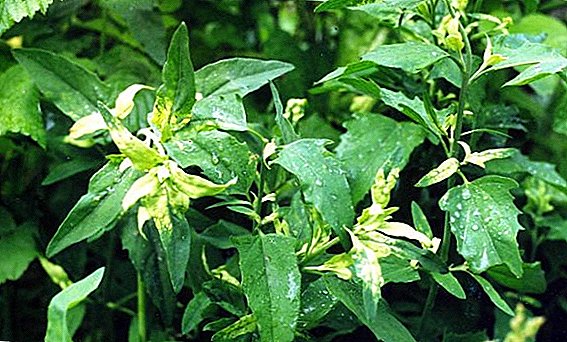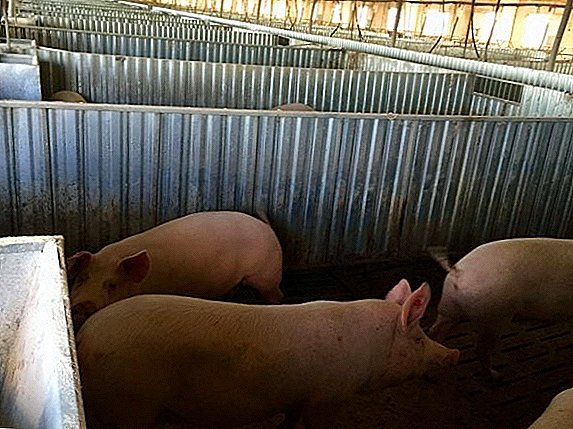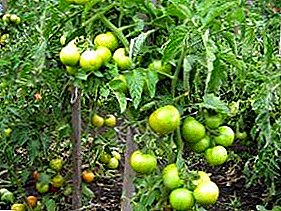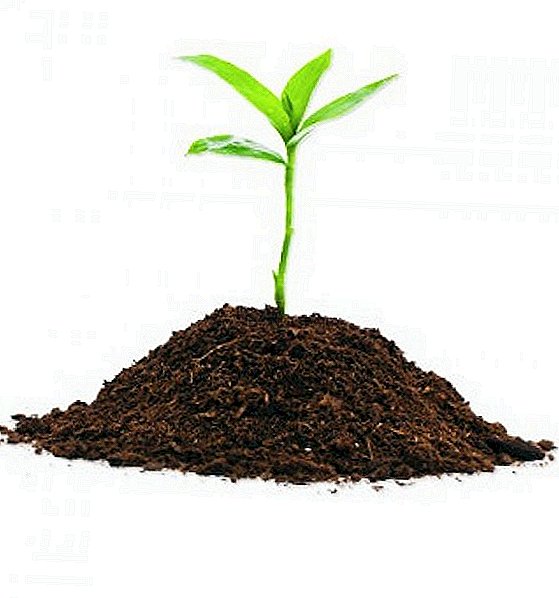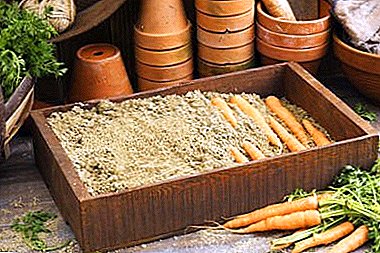
Carrots are a real garden beauty, but it is difficult to keep them fresh for use in winter. Root crops are capricious and demanding storage conditions. Fruits are particularly susceptible to germination and fungal infection (begin to rot).
How to keep carrots fresh and tasty until next season? What should be the storage sand: dry or wet? You will find answers to the questions in the article.
General facts about carrots
Carrot is a two-year culture whose homeland is Afghanistan. In the first year of growth, a rosette of tops and a juicy root crop are formed. Growing next year is necessary to obtain seeds.
The content of vitamins in the composition of carrots surpasses other vegetables and some meat and dairy products. Root contains trace elements and minerals in large quantities:
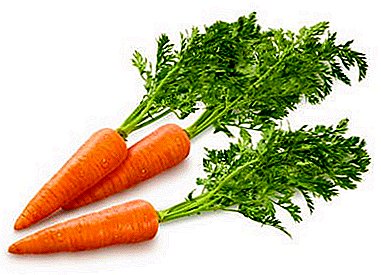 calcium;
calcium;- sodium;
- iron and iodine;
- phosphorus;
- magnesium.
The effect of carrots on the body is complex: antiseptic, anti-inflammatory, expectorant, choleretic. Root crop has a beneficial effect on the digestive tract. It is possible to eat a vegetable at any time of the year provided it is properly stored. Carrots are also allowed to dry, freeze, pickle and pickle.
Is the vegetable suitable for prolonged storage in the basement?
Unlike other vegetables, carrots have a thinner and delicate skin. At the slightest violation of its integrity, bacteria and fungi penetrate inside, the root crop begins to deteriorate and rot. Important rules for high-quality storage are the absence of damage on the peel and the choice of carrots of special varieties.
Experienced gardeners recommend late-ripening and mid-season varieties:
- Chantonne (proven variety with bright orange large fruits).
- Giant Ross.
- Nayarit
- Karotinka (feature - the absence of a hard core).
If the conditions for storing root vegetables are unsuitable - carrots will germinate or rot. For better maturation it is important to prepare the room before laying the root crops. Among the obligatory actions are the cleaning of the old crop, disinfection and whitewashing of the walls, airing.
Can I use this material?
 Sanding technology is popular among gardeners who have a cool basement, cellar or garage pit. Storage in the sand is faster and more convenient than storage in clay solution.
Sanding technology is popular among gardeners who have a cool basement, cellar or garage pit. Storage in the sand is faster and more convenient than storage in clay solution.
Sand allows you to maintain a certain temperature, minimizes the evaporation of moisture, recycles carbon dioxide and has a preservation effect on carrots. Also this material will not allow the fungus to develop.
Wet or dry: which one is better?
Wet sand will prevent the peel from drying out - the carrot will remain fresh and juicy until spring. At 1 bucket of sand enough 1 liter of water. Check the level of humidity is quite simple: you need to squeeze the sand and knead it in your hand. The material should not crumble, water should not flow out of it.
Features sanding technology
Such storage will extend the maturation period and allow carrots to be stored without problems until spring. Sand will prevent the evaporation of moisture, which will prevent the processes of decay. Also, the material will provide a constant air temperature during storage.
For better results, you can add chalk to the sand. It will act as a preservative: stop the movement of the juice inside the carrot and clog the pores. When adding chalk to sand, you need to put the fruit vertically. (do not lay out in layers, but put in a bucket with the top of the head up).
Advantages and disadvantages
Carrots in the sand can be stored in the cellar or in the garage hole, or on a regular balcony. The main rule is a long distance from radiators.
What other advantages of this method:
 Material depletes excess moisture, keeps fruits dry.
Material depletes excess moisture, keeps fruits dry.- Sand "warms" carrots if the cellar is cold, or cools if warm air enters the cellar.
- Carrot life is 6-8 months.
Among the drawbacks are the stickiness of wet sand to the fruit (before cleaning, the carrots will need to be rinsed), time and effort required.
Preparation phase: list of required items
Before laying the vegetable need to prepare the tank and water. Carrots can be stored in wooden containers or boxes that hold 15-17 kg. Replacing the boxes - ordinary buckets. The volume of water depends on the amount of the harvest: 1 bucket - 1 liter, 1 box - 1.5-2 l.
Features
Store root should be in clay or loamy sand. It is not recommended to take river sand. The volume of material is determined on the basis of: for 1 kg of fruit - 0.5 m3 of sand. Its humidity should not exceed 65%.
How to save correctly?
Before laying in the boxes you need to prepare the fruit. After digging from the beds you need to let the carrots lie down (the optimal time is 2-4 days). During this time the peel dries, the juices stabilize. Next, you need to carry out the selection - for storage to choose the fruits of medium and large size without damage and cracks. Cut the tops. Wash carrots as desired.
How to put carrots in boxes:
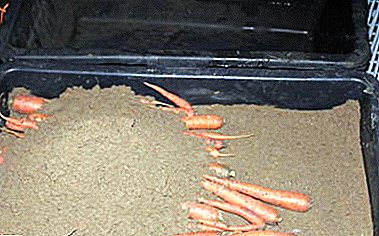 Cover the bottom of the box with cellophane or film so that the sand does not spill out. In cellophane, make small holes for air intake (you can pierce it several times with a knife).
Cover the bottom of the box with cellophane or film so that the sand does not spill out. In cellophane, make small holes for air intake (you can pierce it several times with a knife).- Put sand on the film with a layer of 2-3 cm. The size of the layer does not depend on whether the sand is dry or wet.
- Put the fruits so that they do not touch each other (during storage, the carrots will breathe).
- Pour a layer of sand 10 mm thick onto the vegetables.
- Alternate carrots and sand until the container is full. It is advisable to close the box lid.
TIP! When the vertical storage method at the bottom of the bucket you need to fall asleep dry sand with a layer of 6-10 cm. Insert carrots into it with the crown up and fill it with wet sand from above.
Will there be difficulties?
Problems can arise from improper agricultural cultivation. The increased content of nitrogen and organic fertilizers in the soil, abundant watering, late harvesting - all this will affect the quality of carrot storage. From the list of the disease significant harm to the fruit can bring:
- white and black rot;
- fomoz (dry rot).
Signs of infection - the appearance of dark spots and transverse stripes on the peel, the formation of voids under them, rotting tops. As a result, the flesh becomes rotten, carrots deteriorate. The source of infection is contaminated planting material, post-harvest residues or an old crop in the basement.
Diseases will spread faster when high humidity and elevated temperature in the basement or cellar. Rot develops foci and quickly moves from sick to healthy root crops. It is important to notice early signs and discard infected fruit.
Storing carrots in the sand is a proven technology that has several important advantages. Sand minimizes the risk of the onset of rotting processes, maintains the temperature, preserves the juiciness and taste of the fruit. Subject to the recommendations of the roots will remain fresh for 6-8 months.
- in sugar bags;
- in packages;
- in sawdust;
- in the moss.


 calcium;
calcium; Material depletes excess moisture, keeps fruits dry.
Material depletes excess moisture, keeps fruits dry. Cover the bottom of the box with cellophane or film so that the sand does not spill out. In cellophane, make small holes for air intake (you can pierce it several times with a knife).
Cover the bottom of the box with cellophane or film so that the sand does not spill out. In cellophane, make small holes for air intake (you can pierce it several times with a knife).

